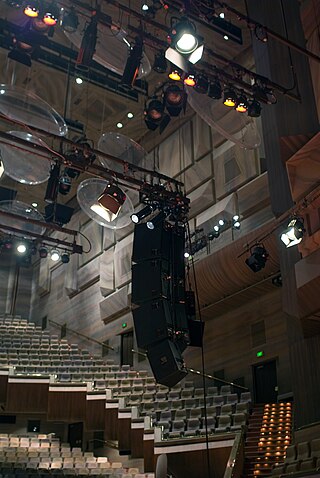
Acoustics is a branch of physics that deals with the study of mechanical waves in gases, liquids, and solids including topics such as vibration, sound, ultrasound and infrasound. A scientist who works in the field of acoustics is an acoustician while someone working in the field of acoustics technology may be called an acoustical engineer. The application of acoustics is present in almost all aspects of modern society with the most obvious being the audio and noise control industries.
A signal generator is one of a class of electronic devices that generates electrical signals with set properties of amplitude, frequency, and wave shape. These generated signals are used as a stimulus for electronic measurements, typically used in designing, testing, troubleshooting, and repairing electronic or electroacoustic devices, though it often has artistic uses as well.

A loudspeaker is an electroacoustic transducer that converts an electrical audio signal into a corresponding sound. A speaker system, also often simply referred to as a "speaker" or "loudspeaker", comprises one or more such speaker drivers, an enclosure, and electrical connections possibly including a crossover network. The speaker driver can be viewed as a linear motor attached to a diaphragm which couples that motor's movement to motion of air, that is, sound. An audio signal, typically from a microphone, recording, or radio broadcast, is amplified electronically to a power level capable of driving that motor in order to reproduce the sound corresponding to the original unamplified electronic signal. This is thus the opposite function to the microphone; indeed the dynamic speaker driver, by far the most common type, is a linear motor in the same basic configuration as the dynamic microphone which uses such a motor in reverse, as a generator.

In electronics and telecommunications, a radio transmitter or just transmitter is an electronic device which produces radio waves with an antenna. The transmitter itself generates a radio frequency alternating current, which is applied to the antenna. When excited by this alternating current, the antenna radiates radio waves.
This is not for Audiophile, the music and sports streaming website. The below is for the definition of the word audiophile.

THX is a suite of high fidelity audiovisual reproduction standards for movie theaters, screening rooms, home theaters, computer speakers, video game consoles, car audio systems, and video games. The famous THX trailer that precedes movies is based on the Deep Note, with a distinctive glissando up from a rumbling low pitch.
In audio signal processing and acoustics, an echo is a reflection of sound that arrives at the listener with a delay after the direct sound. The delay is directly proportional to the distance of the reflecting surface from the source and the listener. Typical examples are the echo produced by the bottom of a well, by a building, or by the walls of an enclosed room and an empty room. A true echo is a single reflection of the sound source.

Surround sound is a technique for enriching the fidelity and depth of sound reproduction by using multiple audio channels from speakers that surround the listener. Its first application was in movie theaters. Prior to surround sound, theater sound systems commonly had three screen channels of sound that played from three loudspeakers located in front of the audience. Surround sound adds one or more channels from loudspeakers to the side or behind the listener that are able to create the sensation of sound coming from any horizontal direction around the listener.

Acoustical engineering is the branch of engineering dealing with sound and vibration. It includes the application of acoustics, the science of sound and vibration, in technology. Acoustical engineers are typically concerned with the design, analysis and control of sound.
3D audio effects are a group of sound effects that manipulate the sound produced by stereo speakers, surround-sound speakers, speaker-arrays, or headphones. This frequently involves the virtual placement of sound sources anywhere in three-dimensional space, including behind, above or below the listener.

The Gravis UltraSound or GUS is a sound card for the IBM PC compatible system platform, made by Canada-based Advanced Gravis Computer Technology Ltd. It was very popular in the demoscene during the 1990s.

Waves Audio Ltd. is a developer and supplier of professional digital audio signal processing technologies and audio effects, used in recording, mixing, mastering, post production, broadcast, and live sound. The company's corporate headquarters and main development facilities are located in Tel Aviv, with additional offices in the United States, China, and Taiwan, and development centers in India and Ukraine.

Wave field synthesis (WFS) is a spatial audio rendering technique, characterized by creation of virtual acoustic environments. It produces artificial wavefronts synthesized by a large number of individually driven loudspeakers. Such wavefronts seem to originate from a virtual starting point, the virtual source or notional source. Contrary to traditional spatialization techniques such as stereo or surround sound, the localization of virtual sources in WFS does not depend on or change with the listener's position.
Sound from ultrasound is the name given here to the generation of audible sound from modulated ultrasound without using an active receiver. This happens when the modulated ultrasound passes through a nonlinear medium which acts, intentionally or unintentionally, as a demodulator.
A rotary woofer is a subwoofer-style loudspeaker which reproduces very low frequency content by using a conventional speaker voice coil's motion to change the pitch of an impeller rotating at a constant speed. The pitch of the fan blades is controlled by the audio signal presented to the voice coil, and is able to swing both positive and negative, with respect to a zero pitch spinning blade position. Since the audio amplifier only changes the pitch of the blades, it takes much less power, per dB of generated acoustic sound level, to drive a rotary woofer than to power a conventional subwoofer, which uses a moving electromagnet placed within the field of a stationary permanent magnet to drive a cone which then displaces air. Rotary woofers excel at producing sounds below 20 Hz, below the normal hearing range; when installed in the wall of a sealed room, they can produce audio frequencies down to 0 Hz, a static pressure differential, by simply compressing the air in the sealed room.

In sound recording and reproduction, audio mixing is the process of optimizing and combining multitrack recordings into a final mono, stereo or surround sound product. In the process of combining the separate tracks, their relative levels are adjusted and balanced and various processes such as equalization and compression are commonly applied to individual tracks, groups of tracks, and the overall mix. In stereo and surround sound mixing, the placement of the tracks within the stereo field are adjusted and balanced. Audio mixing techniques and approaches vary widely and have a significant influence on the final product.

Crystal River Engineering Inc. was an American technology company best known for their pioneering work in HRTF based real-time binaural, or 3D sound processing hardware and software. The company was founded in 1989 by Scott Foster after he received a contract from NASA to create the audio component of VIEW, a virtual reality based training simulator for astronauts. Crystal River Engineering was acquired by Aureal Semiconductor in 1996.
Diffuse field acoustic testing is the testing of the mechanical resistance of a spacecraft to the acoustic pressures during launch.
3D sound reconstruction is the application of reconstruction techniques to 3D sound localization technology. These methods of reconstructing three-dimensional sound are used to recreate sounds to match natural environments and provide spatial cues of the sound source. They also see applications in creating 3D visualizations on a sound field to include physical aspects of sound waves including direction, pressure, and intensity. This technology is used in entertainment to reproduce a live performance through computer speakers. The technology is also used in military applications to determine location of sound sources. Reconstructing sound fields is also applicable to medical imaging to measure points in ultrasound.

WaveNet is a deep neural network for generating raw audio. It was created by researchers at London-based AI firm DeepMind. The technique, outlined in a paper in September 2016, is able to generate relatively realistic-sounding human-like voices by directly modelling waveforms using a neural network method trained with recordings of real speech. Tests with US English and Mandarin reportedly showed that the system outperforms Google's best existing text-to-speech (TTS) systems, although as of 2016 its text-to-speech synthesis still was less convincing than actual human speech. WaveNet's ability to generate raw waveforms means that it can model any kind of audio, including music.











